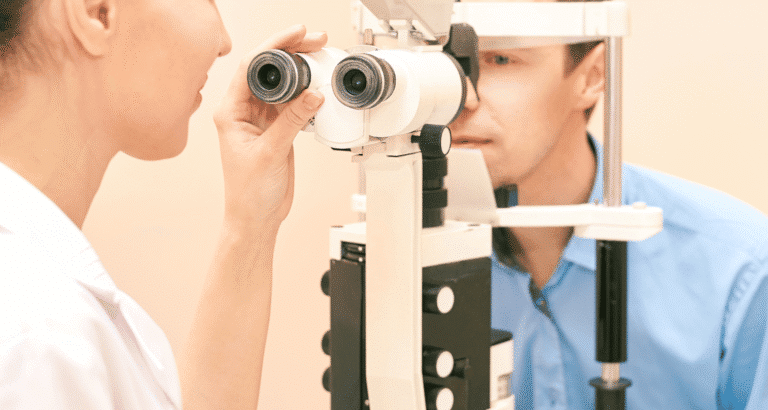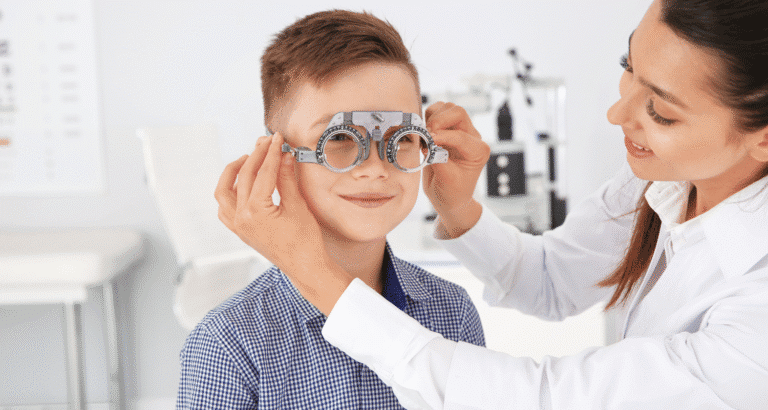When you begin to struggle with reading fine print or needing to hold books at arm’s length, the question often arises: How common is farsightedness? Also known as hyperopia, farsightedness is one of the most common vision disorders among children and adults. Although it is harmless and often inconsequential in many cases, some people may have trouble focusing on close-up objects and experience headaches or eye strain, or feel frustrated with tasks that require near vision.
Knowing how common farsightedness is, who is most at risk, and what treatment options are available can help alleviate your concerns. Farsightedness can occur at different ages and for a variety of reasons, but when corrected and diagnosed appropriately, it doesn’t have to hinder your quality of life.
Farsightedness Prevalence Across the Globe
The prevalence of farsightedness varies significantly by age, genetics, and geographic region. It is estimated that approximately 10-15% of the global population has some degree of hyperopia. This actually makes it one of the most commonly diagnosed vision problems on regular eye checks.
Interestingly, hyperopia is more prevalent in certain regions. For example, a faster rate is reported in some areas of North America and Europe than in Asian populations, where myopia (nearsightedness) is more prevalent. These differences are likely due to genetic and environmental factors, as well as environmental factors such as the organization and quality of education systems, and lifestyle.
Hyperopia Frequency in Different Age Groups
The prevalence of hyperopia varies with age. Most babies are born slightly farsighted, which often corrects as their eyes grow. However, children with more severe hyperopia may require glasses to prevent vision strain.
Presbyopia becomes increasingly common in adults as they reach middle age and beyond. That is partially because of the normal loss of flexibility in the eye’s lens, which causes near objects to become harder to focus on. Even if you had perfect eyesight when you were younger, age-related changes could eventually cause farsightedness.
Farsightedness Statistics You Should Know
When it comes to farsightedness statistics, researchers have determined that this condition is anything but uncommon. The findings from these studies provide valuable information on the frequency of hyperopia and which people in different regions and age groups are most affected.
- Approximately 5–10% of preschoolers are hyperopic.
- It may affect up to 2% of school-age children in certain populations.
- Symptoms typically appear around age 40, and their prevalence increases nearly linearly with age.
- Nearly half of adults develop mild to moderate hyperopia after the age of 60.
- These numbers underscore the importance of having eyes tested at every age.
Causes of Hyperopia
The factors associated with farsightedness are based on the structure of the eye. Farsightedness is the result of an eyeball that is too short or a cornea that is too flat. This misdirected light causes blurred images on the retina, which, in turn, causes near-sightedness. Other contributing factors include:
- Genetics: A family history of hyperopia greatly increases risk.
- Developmental issues: In children, improper growth of the eye can lead to long-term farsightedness.
- Health conditions: Rarely, diseases such as tumors or diabetes-related changes may alter the eye’s structure, leading to hyperopia.
Symptoms That Signal Farsightedness
The symptoms of hyperopia don’t affect everyone, especially if it’s only a mild case. But as the eye struggles to make up for this, other symptoms can start to occur:
- Blurry vision when reading or looking at objects up close.
- Eye strain or discomfort after prolonged near work.
- Headaches, particularly after reading or using a computer.
- Difficulty focusing on small print.
In the case of children, a child may squint or strain to see clearly or struggle with reading, or avoid close-up tasks such as drawing.
Hyperopia in Children
Hyperopia in children is of particular interest as uncorrected visual concerns can impact learning and development. Youngsters may not know that they’re seeing differently, so it’s crucial to have regular eye examinations. Left undiagnosed, hyperopia can cause strabismus (crossed eyes) or amblyopia (lazy eye) in some patients who would need to be treated early for the best result.
The good news is that if identified early, farsightedness in children can be easily corrected with a corrective pair of glasses or contact lenses. In many cases, the eye’s growth and development will diminish the degree of hyperopia as a child grows.
Correction Options for Hyperopia
The good news is that there are several successful solutions for farsightedness, and most of them provide individuals with clear vision, as well as symptom-free days. These options differ in technique and applicability, but the most popularly used, widely advised solutions are:
Glasses
Why is it important to wear prescription glasses for farsightedness? They achieve this by manipulating the refraction of light through a convex lens, redirecting light so that it focuses properly on the retina, thereby improving near vision and making reading easier. Today’s lens technology offers lightweight, thin, and glare-resistant options, so comfortable that you may hardly notice wearing them.
Contact lenses
If you are a contact lens wearer, it will provide you with even better vision correction, allowing you to see your surroundings without glasses. They function similarly to glasses, but sit directly on the eye. For sports, social events, and everyday wear, many people find them especially convenient.
Refractive surgery
Surgical options include LASIK, PRK, or LASEK to reshape the cornea and improve your ability to focus light. These procedures also help eliminate or reduce the need for glasses and/or contacts for certain patients, providing a more permanent solution for those who are suitable candidates.
Understanding the Eye Condition
As an eye defect, farsightedness differs from lens and corneal conditions that affect vision (including myopia and astigmatism). Its impact depends on severity: mild cases may have no symptoms, while severe cases cause significant visual discomfort. Unlike conditions such as presbyopia, however, the actual state of hyperopia is not worsened by eye strain, although it remains relatively stable as one ages. Age-related changes within the lens can lead to a more noticeable condition over time.

Risk Factors That Influence Hyperopia
Several risk factors increase your likelihood of being farsighted, so understanding them is useful for both avoiding and detecting the condition early. Several factors contribute to the development, from genetics to aging and even certain medical conditions:
- Family history: Children whose parents are farsighted are more likely to have the condition.
- Age: Lens flexibility declines with age, elevating the risk.
- Medical causes: Certain systemic conditions may alter the shape of the eye.
- Race: Several studies have shown that the highest prevalence of hyperopia is among Caucasians.
Knowing these risk factors enables people to be proactive in getting routine eye exams.
Glasses as a Reliable Solution
Among various remedial measures, spectacles are the most preferred. They are free from side effects, inexpensive, and adaptable to one’s lifestyle. Lens technology has advanced to the point that glasses are now lighter and thinner, and can even filter glare for computer users. Glasses can be a crucial tool for children to help them learn and grow as they should.
Surgery as a Permanent Option
The surgery can be a life-changing solution for individuals who want to see without the need for corrective lenses, such as glasses or contact lenses. One of the most familiar procedures is LASIK, which uses lasers to reshape the cornea. LASEK and PRK are options for patients who may not qualify for LASIK. Although surgery is generally considered safe, it carries risks, and consultations with an eye specialist are recommended.
The Importance of an Eye Test
The most reliable way to determine whether someone has farsightedness is with a thorough eye exam. Eye care professionals can use various techniques to determine the focusing power of your eyes, including retinoscopy, Refraction, Automated Refraction, and Manual Refraction. This test helps the doctor obtain an approximation of the prescription they will use to correct your vision (in other words, a starting point). Early diagnosis not only facilitates symptomatic recovery but also prevents associated complications, including eye strain and a poor decline in quality of life.
The Role of Genetics
Genetics plays a significant role in determining who develops hypermetropia. It is already known that specific genes play a role in eye growth, and mutations in them can increase susceptibility to developing refractive errors. When hyperopia is in your family’s history, it’s particularly essential to have regular eye tests carried out, even though you may not be experiencing symptoms.
Vision Issues Related to Hyperopia
Leaving farsightedness uncorrected can lead to the development of other vision problems over time. Eye fatigue, nearsightedness, headaches, and eye muscle tension are also common. In more serious cases, children may develop crossed eyes, and adults may experience increased frustration while performing reading or computer work during the day. Timely correction of these conditions can prevent long-term sequelae.
Conclusion
So, how common is farsightedness? The response is that it affects millions worldwide, with varying rates of occurrence due to age, genetics, and other risk factors. From kids who are struggling in school to adult citizens looking for surgical remedies, hyperopia can significantly impact daily life. The good news is that there are several effective ways to correct a lazy eye, including corrective lenses (glasses or contacts) and surgery. Frequent eye exams and knowing the signs keep farsightedness at bay before it becomes disruptive to everyday living. For professional advice, eye exams, and individualized treatments, see Barnes Talero Eyecare.
FAQs
At what age does farsightedness start?
Hyperopia may be hereditary, but it can also exist at birth; many babies are born with mild to moderate farsightedness. The condition is usually transient, with most young children outgrowing it as their eyes mature; however, some are left with the condition through adolescence and into adulthood.
What’s rare, nearsighted, or farsighted?
Worldwide, people are more likely to be nearsighted (myopia) than farsighted. Millions still deal with hyperopia, but although it’s yet another common vision deficit and less common than the increasing instances of nearsightedness around the globe (particularly among younger people who are more impacted by lifestyle as well as screens).
Can farsightedness go away?
Mild farsightedness in children may get better on its own as the eye grows and lengthens. But in the case of adults, hyperopia does not generally go away by itself and is often treated with glasses, contacts, or surgery.
Can you suddenly develop farsightedness?
Most people develop farsightedness slowly, although it is possible for the condition to change suddenly if you are older, become ill, or experience an injury. If blurry near-sighted vision comes out of nowhere, it’s time to book an eye test to ensure there are no underlying health issues.





